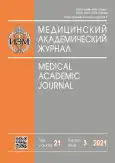The role of coinfection with influenza viruses in the pathogenesis of severe infection in patients with COVID-19
- Authors: Shvedova T.N.1, Kopteva O.S.2, Kudar P.A.3, Lerner A.A.1,4, Desheva Y.A.2,3
-
Affiliations:
- Vsevolozhsk Clinical Multidisciplinary Hospital
- Saint Petersburg State University
- Institute of Experimental Medicine
- North-Western State Medical University named after I.I. Mechnikov
- Issue: Vol 21, No 3 (2021)
- Pages: 159-164
- Section: Conference proceedings
- URL: https://ogarev-online.ru/MAJ/article/view/78155
- DOI: https://doi.org/10.17816/MAJ78155
- ID: 78155
Cite item
Abstract
BACKGROUND: Despite the continuing global spread of the coronavirus infection COVID-19 caused by the SARS-CoV-2 coronavirus, the mechanisms of the pathogenesis of severe infections remain poorly understood. The role of comorbidity with other seasonal viral infections, including influenza, in the pathogenesis of the severe course of COVID-19 remains unclear.
MATERIALS AND METHODS: The present study used sera left over from ongoing laboratory studies of patients with varying degrees of severity of COVID-19. The study was approved by the Local Ethics Committee of the Federal State Budgetary Scientific Institution “IEM” (protocol 3/20 from 06/05/2020). We studied 28 paired samples obtained upon admission of patients to the hospital and after 5–7 days of hospital stay. Paired sera of patients with COVID-19 were tested for antibodies to influenza A and B viruses. The presence of IgG antibodies specific to the SARS-CoV-2 spike (S) protein was studied using an enzyme-linked immunosorbent assay (ELISA). The serum concentration of C-reactive protein and the neutrophil-lymphocyte ratio on the day of hospitalization were also assessed.
RESULTS: At least a 4-fold increase in serum IgG antibodies to SARS-CoV-2 S protein was found both in patients with PCR-confirmed SARS-CoV-2 infection and without PCR confirmation. It was shown that out of 18 patients with moderate and severe forms of COVID-19 infection, six of them showed at least a 4-fold increase in antibodies to influenza A/H1N1, in one to influenza A/H3N2 and in two cases to the influenza B. Laboratory data in these two groups were characterized by significant increases in serum C-reactive protein and neutrophil-lymphocyte ratio concentrations compared with the moderate COVID-19 group.
CONCLUSIONS: Serological diagnostics can additionally detect cases of coronavirus infection when the virus was not detected by PCR. In moderate and severe cases of COVID-19, coinfections with influenza A and B viruses have been identified. The results obtained confirm the need for anti-influenza immunization during the SARS-CoV-2 pandemic. Influenza virus screening can significantly improve patient management because recommended antiviral drugs (neuraminidase inhibitors) are available.
Full Text
##article.viewOnOriginalSite##About the authors
Tamara N. Shvedova
Vsevolozhsk Clinical Multidisciplinary Hospital
Author for correspondence.
Email: toma_nn@mail.ru
ORCID iD: 0000-0002-6649-8150
Head of the Clinical Diagnostic Laboratory
Russian Federation, Leningrad Region, VsevolozhskOlga S. Kopteva
Saint Petersburg State University
Email: olga.s.kopteva@yandex.ru
ORCID iD: 0000-0002-2645-3433
SPIN-code: 7630-3067
Postgraduate student
Russian Federation, Saint PetersburgPolina A. Kudar
Institute of Experimental Medicine
Email: polina6226@mail.ru
Student, Department of Virology
Russian Federation, Saint PetersburgAnna A. Lerner
Vsevolozhsk Clinical Multidisciplinary Hospital; North-Western State Medical University named after I.I. Mechnikov
Email: sever67@bk.ru
ORCID iD: 0000-0001-5848-6486
PhD (Med.), Chief Staff Ofisser for Clinical Laboratory Diagnostics; assistant of the Department of Clinical Laboratory Diagnostics
Russian Federation, Leningrad Region, Vsevolozhsk; Saint PetersburgYuliya A. Desheva
Saint Petersburg State University; Institute of Experimental Medicine
Email: desheva@mail.ru
ORCID iD: 0000-0001-9794-3520
MD, PhD, DSc (Med.), Associate Professor, Professor of the Department of Fundamental Problems of Medicine and Medical Technologies, Faculty of Dentistry and Medical Technologies; Leading Researcher of the Department of Virology
Russian Federation, Saint PetersburgReferences
- Hu B, Guo H, Zhou P, Shi ZL. Characteristics of SARS-CoV-2 and COVID-19. Nat Rev Microbiol. 2021;19(3):141–154. doi: 10.1038/s41579-020-00459-7
- Wu X, Cai Y, Huang X, et al. Co-infection with SARS-CoV-2 and influenza A virus in patient with pneumonia, China. Emerg Infect Dis. 2020;26(6):1324–1326. doi: 10.3201/eid2606.200299
- Cuadrado-Payán E, Montagud-Marrahi E, Torres-Elorza M, et al. SARS-CoV-2 and influenza virus co-infection. Lancet. 2020;395(10236):e84. doi: 10.1016/S0140-6736(20)31052-7
- Hu B, Huang S, Yin L. The cytokine storm and COVID-19. J Med Virol. 2021;93(1):250–256. doi: 10.1002/jmv.26232
- Wu C, Chen X, Cai Y, et al. Risk factors associated with acute respiratory distress syndrome and death in patients with coronavirus disease 2019 pneumonia in Wuhan, China. JAMA Int Med. 2020;180(7):934–943. doi: 10.1001/jamainternmed.2020.0994
- Rowe T, Abernathy RA, Hu-Primmer J, et al. Detection of antibody to avian influenza A (H5N1) virus in human serum by using a combination of serologic assays. J Clin Microbiol. 1999;37(4):937–943. doi: 10.1128/JCM.37.4.937-943.1999
- Yue H, Zhang M, Xing L, et al. The epidemiology and clinical characteristics of co-infection of SARS-CoV-2 and influenza viruses in patients during COVID-19 outbreak. J Med Virol. 2020;92(11):2870–2873. doi: 10.1002/jmv.26163.
- Bai L, Zhao Y, Dong J, et al. Coinfection with influenza A virus enhances SARS-CoV-2 infectivity. Cell Res. 2021;31(4):395–403. doi: 10.1038/s41422-021-00473-1
- Stringer D, Braude P, Myint PK, et al. The role of C-reactive protein as a prognostic marker in COVID-19. Int J Epidemiol. 2021;50(2):420–429. doi: 10.1093/ije/dyab012
- Kulkarni A, Divya Prabhu, Likitesh AB, et al. Utility of neutrophil-lymphocyte ratio (NLR) as an indicator of disease severity and prognostic marker among patients with COVID-19 infection in a tertiary care centre in Bangalore – a retrospective study. Journal of Evidence Based Medicine and Healthcare. 2021;8(16):1020–1024. doi: 10.18410/jebmh/2021/197
Supplementary files






